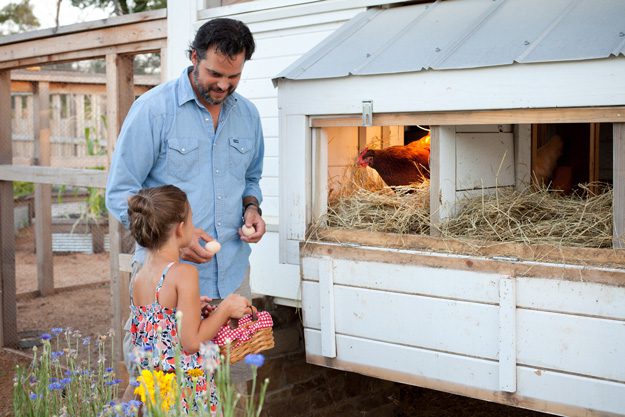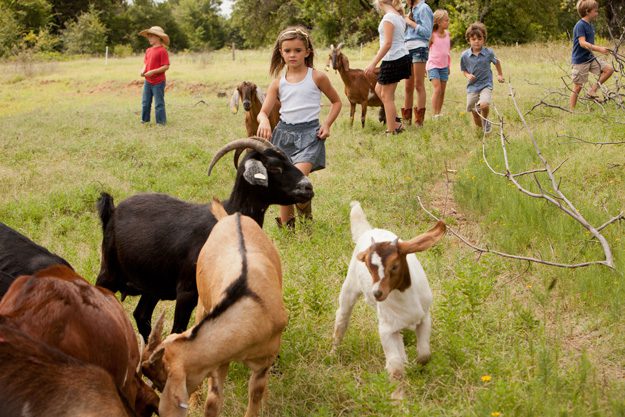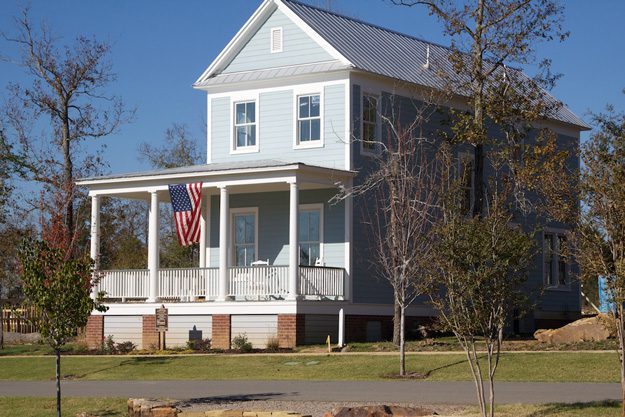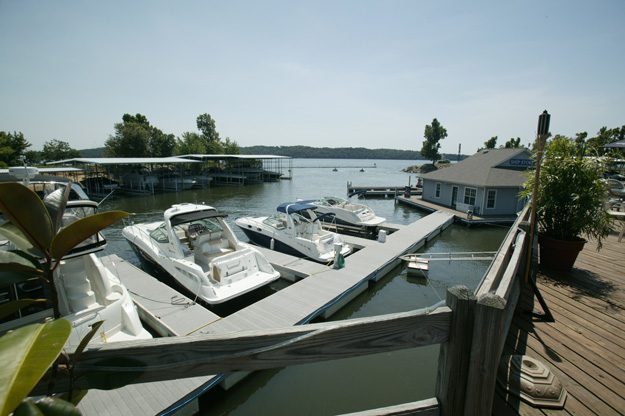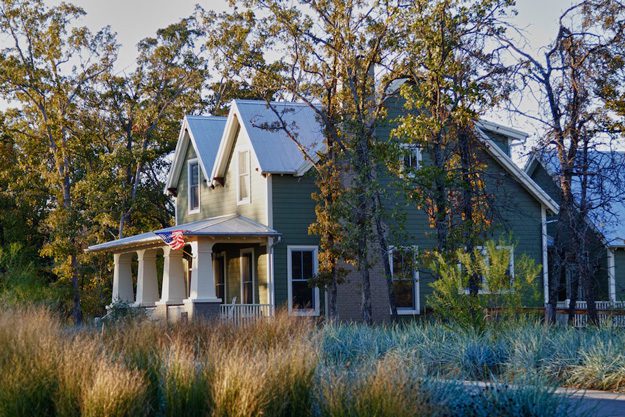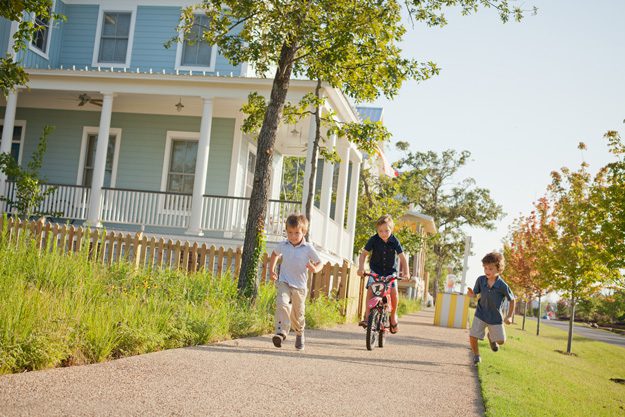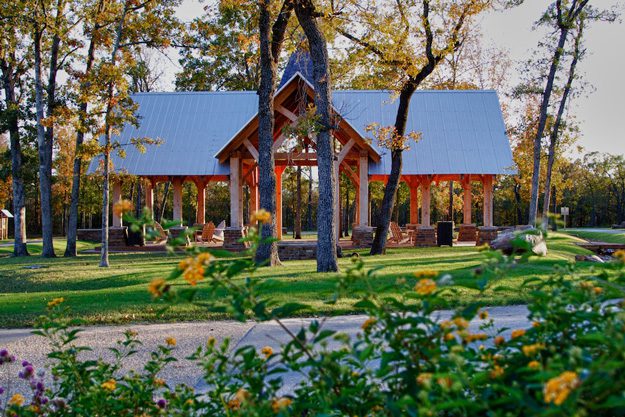
all photos courtesy Carlton Landing
The morning line at Starbucks and the numb commute. The screech of tires as motorcycles race each other down thoroughfares. Barking dogs, trains, ambulance sirens. The dull thrum of nearby highway traffic so familiar that it’s barely noticeable until it’s gone.
Sound familiar? It does if you are an urban resident. Living in the city has its conveniences, but sometimes, peace and quiet are hard to come by.
Picture this instead: A sky so dark you can count the stars, on a night so quiet the owls seem like your only neighbors. Days spent under fans on long porches, over-looking wide green spaces where children play tag and Frisbee. Strolling a few short minutes to boats and kayaks, or to a town barbecue or outdoor movie. Deer running across your path on an early morning walk, hummingbirds hovering in wildflower patches along the way.
It’s a real place, and it’s right here in Oklahoma.
Oklahoma’s newest resort town is Carlton Landing, a storybook community tucked into a small cove on the shores of Lake Eufaula in Pittsburg County. The new township – only incorporated in late 2013 – is the brainchild of town founder and Oklahoma City developer Grant Humphreys and his family. Charmed by the serene luxury of Seaside, Fla., Humphreys envisioned a very special Oklahoma community: a haven for Oklahoma families built on the principles of hospitality, comfort and sustainability.
“We see a need to offer a place where life can be well-lived,” Humphreys says of the town’s creation. “Unfortunately, the cultural norm today is a lifestyle that is too busy, stressed out, relationally disconnected and out-of-balance. Folks spend too much time, energy and money chasing after things that don’t meet their most important needs. We wanted to offer a place where people can enjoy time together, spend good times with friends and family, reconnect with nature and recharge their batteries.”
Conscientiously Comfy
The inception of Carlton Landing was inspired both by Humphreys’ time in Seaside and by memories of golden childhood summers with his grandparents on Lake Eufaula. These memories not only determined the name of the village, but also set the tone for the character of its community.
“My grandfather’s name was Jack Carlton Humphreys,” Humphreys remembers. “We just called him Poppy. In his honor, I was given the same middle name of Carlton. He and my grandmother built a lake house on this portion of Lake Eufaula back in the early ‘70s, and that lake house turned out to be a real blessing, as our family grew exponentially over the next four generations. Back in 2007, when we were trying to come up with a name [for the town], we loved the idea of honoring Poppy with a namesake. We felt that his kindness, generosity, personality and character were worthy of a town being named after him. And it’s interesting to see how the culture of Carlton Landing, in many ways, points back to Poppy. Folks are joyful, generous, hospitable, kind and easy-going. These are all qualities my grandfather was known for.”

Everything about the freshman township, from architecture to gardens, has been curated to craft a fairy-tale community. Humphreys and designer Andres Duany, from urbanist firm Duany Plater-Zyberk – locations in Miami, Washington, D.C., and Charlotte – were inspired by the planning philosophy of New Urbanism. Despite the name, the concept itself isn’t new. Since the 1980s, urban planners and developers have been casting nostalgic eyes upon the walkable, economically diverse and regionally rooted towns of the pre-automobile world. New Urbanism incorporates these tenets, along with a commitment to green building, limited urban growth and a community-centric layout. In Florida, towns like Seaside, which readers may recognize as the picturesque setting of The Truman Show, are textbook examples of New Urbanism in practice. With the founding of Carlton Landing, Humphreys plans to bring that conscientiously comfortable living home to the heartland.
“New Urbanism is the idea that communities should be designed around people rather than the automobile,” Humphreys says. “It’s really how communities grew organically before World War II. If you look at European villages or the older portions of cities which were developed before the 1940s, you’ll find a diverse community with different tax brackets and life stages on the same block. You’ll find a variety of home types, styles and price points integrated into one neighborhood rather than segregated to different gated communities. And you’ll find goods and services conveniently located within a five- or 10-minute walk of your front door. New Urbanists have figured out how to recreate these kind of places, and the track record established over the past 35 years since the Seaside master plan was first conceived proves that human nature hasn’t changed. People still prefer to live in community over isolation. They prefer to have the option to walk rather than be forced to commute by car. They prefer a rich and diverse community over demographic homogeny.”
Humphreys concedes that New Urbanism is gaining in popularity, but it is still the exception, and not the rule.
“Unfortunately, in our culture today, whether you’re talking about how we eat, how we’re entertained or how we develop land, many people accept the easiest, cheapest and most utilitarian option offered,” he continues. “I think that’s sad, because there’s a rich life – a better option – but only some take the time, or do the work, to bring it about. So it’s not for everyone, but for those who appreciate a life well-lived, it’s definitely for them.”
How To Build A Community
To turn his vision of a New Urbanist haven in Oklahoma into reality, Humphreys purchased 2,000 acres of land on the southern shores of Lake Eufaula, about 10 minutes from the eponymous town. Once past the gates, a one-way road snakes its way through dense forest thick with game birds and deer. Signs guide visitors and new residents deeper into the woods, past the beginnings of an organic farmstead and flocks of sheep and pigs (diligently guarded by a wary Great Pyrenees dog), higher up the ridge until a lookout point emerges. There, just outside the town center, sit two chairs waiting for occupants, overlooking a sweeping vista of the lake. These miles of shoreline may be part of the town, but houses will never stand there. Instead, the homes of Carlton Landing – craftsman, rural gothic, Italianate, Victorian – will all be constructed slightly inland, walkable from the shore, but leaving the town’s prime real estate intact for common grounds to be shared by all. One of these common spaces is slated as the home of the forthcoming nature center, complete with an outdoor amphitheater, wildlife exhibits and a network of trails.
“As stewards of the natural world, we should take great care in the way we develop and construct the built environment,” Humphreys says. “Carlton Landing is located on more than 2,000 acres of gorgeous, wooded, rolling hills. Streams and creeks flow through the woods and wildlife is abundant. So it’s a special place with a great deal of natural beauty. We want to show how Carlton Landing can combine economic growth, with 2,000 homes eventually, with natural preservation. So we design our green spaces around the existing creeks and site hydrology. We preserve the natural shoreline and use native plantings around the trail system in the Nature Center. As we continue to grow, we’ll integrate the organic farm into the master plan, showing how a self-sustaining local food system can be incorporated into a larger scaled master-planned community.”
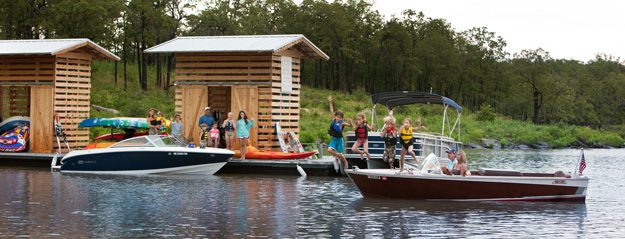
Deeper in the lakeside forest sits the town center, where about 100 homes stand fully built (30 occupied by full-time residents, the rest by part-time weekend residents or currently for sale), with more under construction. Eventually, these homes and more will comprise the town, complete with distinct districts. The Boardwalk District evokes visions of sand and shore, while homes in the Urban District have the chic brick façades associated with urban luxury apartments. Forthcoming homes include examples of the “tiny house” trend. Already, a green town center and several parks exist, where residents and visitors gather beneath pavilions for town cookouts and twilight concerts, flanked by a community pool and a small general store. Steps away is Carlton Landing Academy, a private school that town leaders plan to transition to a charter school. A two-minute walk from the school takes pedestrians to the courtesy dock for the Boat Club, where kayaks and rafts are available for free use at any time, and the two town’s vessels wait for club members to take them on the water. Soon, there will be an entire fleet. But Humphreys says the town is about more than living the lake life.
“Most lake communities have the lake as the sole amenity,” Humphreys says. “In Carlton Landing, the lake is a major amenity, but I think people choose Carlton Landing for the lifestyle and the sense of community first, then for the lake. We have pools, parks, a community garden. Homes share common green spaces that allow you to walk around the neighborhood on trails or sidewalks, so there’s a real sense of walkability. With our community programming, we have food events, outdoor dinners, art showings, open-air concerts and movies in the park. People are able to make a lot of great memories out here. Nothing too fancy or sophisticated. Just good, down-home living and special times with family and friends.”
The town’s planners are hoping to make Carlton Landing an attractive lure for more temporary visitors as well. Already planned for the near future are a boutique hotel, sumptuous shared condos, restaurants, a conference and retreat center, and a destination wedding chapel. Although prospective residents and visitors alike are welcome in the resort town, luxury is definitely the name of the game. An approximately 1,000-square-foot home in the town will set buyers back at least $250,000, while the forthcoming tiny houses will start at around $175,000. But the sticker price hasn’t stopped interested parties, and the budding village continues to attract families looking for a bit of relief from the city’s daily grind.
“Now, with about 100 homes completed and occupied, we are in an exciting season where the vision for Carlton Landing is actually being realized,” Humphreys says. “After setting the stage and getting the project off the ground, we get to see how life actually happens in Carlton Landing. Dinner on the front porch, kids playing in the street and movies in the park are not just an ideal that looks good on Pinterest. It’s real life here.”
About Grant Humphreys
Though Carlton Landing may be his most ambitious project to date, Grant Humphreys is not new to the real estate industry. He has been involved in investment and development deals in Oklahoma for the past 17 years.
His future plans include to build upon the work already done to create Carlton Landing.
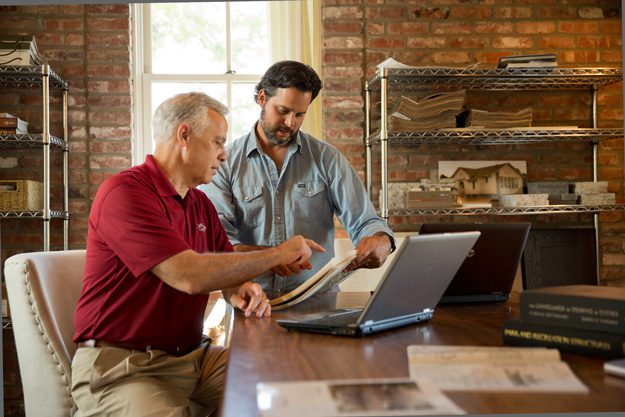
“Carlton Landing is a long-term undertaking that will continue to be built out for the next 30-plus years. With more than 2,500 homes projected, it will have a rich town center and several neighborhood centers,” Humphreys says. “Between these mixed-use and commercial hubs will be more than 2,500 homes and cottages. The planning and vision casting for this is a great creative outlet for me.”
Six years ago, Humphreys began a home building company called Traditional Craft Homes. The company will build about half of the homes in Carlton Landing, around 40 to 50 per year.
“We have a great team running that shop, but I stay involved and really enjoy being directly involved with construction,” he says.
In addition to his construction endeavors, Humphreys remains involved in The Humphreys Company, his family’s business, and as part of that, The Humphreys Fund, which owns investment-grade real estate in 13 states and partners with top developers in select markets.
“We’ve got a great team of guys who find deals and help raise equity. When I’m not working on Carlton Landing, I enjoy staying connected with that work,” Humphreys says.

Oklahoma Resort Communities
Though the newest, Carlton Landing is by no means the first planned resort community in Oklahoma.
Medicine Park (Comanche County): For nearly a century, the cobblestoned paths of Medicine Park have guided guests at the foot of the Wichita Mountains. The community was founded on July 4, 1908, by Oklahoma State Senator Elmer Thomas. Beginning as a small recreation area that had a few swimming and camping spots, the town soon flourished, as people were drawn from the surrounding areas to experience the stark beauty of the Wichitas and the local wildlife. Hotels, spas and businesses began to spring up. Soon, one of the town’s best-known attractions, Bath Lake Park, was added. Over the past century, Medicine Park has hosted everyone from celebrities like Will Rogers and Bob Wills to outlaws like Al Capone, Pretty Boy Floyd and Bonnie and Clyde. Today, Medicine Park continues to be a thriving presence in the mountains of southwest Oklahoma, complete with music festivals, art galleries and, of course, one of the best swimming holes in Oklahoma.
Flint Ridge (Delaware County): In the foothills of the Ozarks near Flint Creek – a swimming hole to rival Medicine Park’s Bath Lake – looms Flint Ridge, a resort community overlooking the Illinois River. The town hosts miles of nature trails, a golf course, camping and cabin rental, and a private canoe launch. Multiple club houses provide memorable views of the Illinois River. A volunteer fire department, a church and a restaurant round out the sleepy mountaintop community. Amenities in this gated village are for residents only, but good news: There’s plenty of property for sale.
Monkey Island (Delaware County): Contrary to its name, Monkey Island is a six-mile-long peninsula on Oklahoma’s storied Grand Lake o’ the Cherokees. Traversed easily by State Highway 125, which ends at its southern tip, this tiny community is home to multiple lake resorts and amenities, including boating, horseback-riding, swimming and best of all, affordable housing. Permanent residents enjoy these activities, as well as the churches and dining options on the “island,” as can vacationers.























